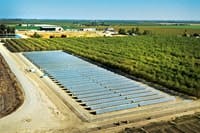Water has been an important aspect in shaping the history of Kerman, Calif. Located in Fresno County in central California, the area was established in 1891 by the Southern Pacific Railroad Co. as a way station, with a watering tank and pump for trains passing through. Later, water from nearby Kings River was brought into the area for irrigation and to sustain the agricultural economy.
Today, water continues to shape the development of the city and has led to a number of projects and upgrades for the city’s public works department.
Adapting to Growth
Although it now serves a population of about 14,500, Kerman’s wastewater treatment plant did not always face the demand it does today.
First constructed in 1975, the plant’s infrastructure consisted of a clarifier and a digester. With a population of only 3,000, the city found the plant too costly to operate and in 1982 switched to an aerated pond treatment system.
“It was fine until they started all the construction. When they started building new homes and a new school, we were out of compliance because they expanded too fast and we couldn’t handle the flow,” said Doug Hearld, water distribution and wastewater manager for the city of Kerman. “That’s when they decided we had to build a new plant.”
In 2009, the city began an upgrade of the treatment plant, which was the largest capital improvement project in its history. At $6.7 million, the project was funded by a $2-million grant from the American Recovery and Reinvestment Act and a $4.7-million loan from California’s State Water Resources Board Clean Water Revolving Loan Fund. The new system went online in June 2011.
The upgrade, which has given the plant a capacity of 3 million gal per day, consists of an influent pump station, headworks and clarifiers. To make use of the original plant, the old aeration tanks were converted into digesters.
A Biolac aeration treatment system also was installed as part of the expansion. Using an aerobic and anaerobic cycle, the system aerates the water, releasing nitrogen to eliminate the addition of nitrates to the water table.
Before the installation of the Biolac system, the plant was reporting biochemical oxygen demand (BOD) and total suspended solids (TSS) of about 200 mg/L and 250 mg/L, respectively. After treatment, BOD is less than 3 mg/L and TSS measures about 5 mg/L.
The Kerman facility also includes a dump site, allowing vacuum trunks that pump portable toilets and septic systems to unload waste.
The plant’s secondary effluent is reclaimed by neighboring alfalfa farmers who use the water for irrigation of their non-food crops.
Powering the Upgrade
Because the new treatment facility is significantly larger than the one built almost 30 years earlier, it used much more energy and was more costly to operate. Increasing population and rising electricity prices also impacted the plant.
To mitigate these additional costs generated by the wastewater treatment plant, Kerman City Manager Luis Patlan began researching solar power generation and its success in other cities. While Patlan looked into ground applications, Hearld looked into installing panels on the plant’s water ponds.
“You can put your solar panels on the ponds and the water keeps them cooler, where they’re more efficient,” Hearld said. “But we didn’t have big enough ponds, so we had to go with the ground application.”
After a competitve bidding process, the city narrowed the selection of potential solar companies down to four. Ultimately, Borrego Solar Systems of San Diego was chosen to design the facility.
What resulted was a 1,680-panel solar installation spread across 3.33 acres. According to Hearld, a 409-kW field will produce 940 mW per year, which is equivalent to 70% of the total energy the plant uses.
Construction of the solar facility began in April 2013 and the facility started up in October. Borrego built the system, which now is owned and operated by ConEdison Solutions. Kerman has entered a 20-year power purchase agreement with ConEdison, which projects that the facility will save the city $1.9 million in that time, according to Hearld—a savings of around $95,000 per year.
“Everything is working fine,” Hearld said. “There were a few bugs in the beginning; they got those worked out and we haven’t had any problems.”
Download: Here


